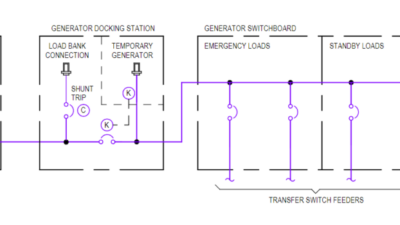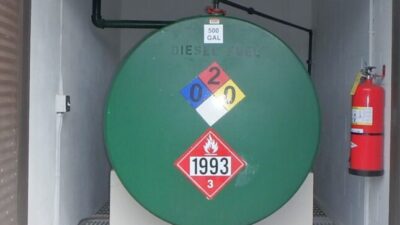When designing generator systems, such as engine-driven generator sets, design engineers must ensure that the generator selection, sizing, and the design of electrical systems are appropriate for the application.
Consider the task of sizing a 277/480 V, 3-phase generator for three different loading and motor-starting methods. All three examples use the following loads:
- One 150-hp motor, Code F, 95% running efficiency, 0.26 starting PF, and 0.86 running PF
- One 200-hp motor, Code G, 95.4% running efficiency, 0.24 starting PF, and 0.87 running PF
- Miscellaneous loads of 75 kVA, 0.84 starting PF, and 0.91 running PF.
Motor load: The following equations are used to calculate SkVA, SkW, RkVA, and RkW:
Where locked-rotor, Code F motor = 5.5 kVA/hp; Code G motor = 6 kVA/hp per NEC, Table 430.7(B)
Miscellaneous load: The following equations are used to calculate SkW and RkW:
Where load kVA remains constant: kVA = SkVA = RkVA
Example 1: A 1,000-kW generator with 2,525 SkVA at 20% voltage dip is selected from the manufacturer’s specification sheet to supply a total load of 2,100 SkVA. The total load of 342 RkW is 34% of the 1,000-kW generator rating. The generator is under-loaded in the final running condition because of the required oversized generator capacity to meet the starting kVA.
Example 2: An 800-kW generator with 2,000 SkVA at 20% voltage dip is selected from the manufacturer’s specification sheet to supply a total load of 1,412 SkVA. The total load of 342 RkW is 43% of the 800-kW generator rating. The generator is under-loaded in the final running condition because of the required oversized generator capacity to meet the starting kVA. When loads were stagger-started (step-loading), the generator SkVA was reduced from the SkVA required in the example of starting all loads concurrently.
Example 3: A 400-kW generator with 765 SkVA at 20% voltage dip is selected from the manufacturer’s specification sheet to supply a total load of 710 SkVA. The total load of 342 RkW is 86% of the 400-kW generator rating. The generator is loaded to around 86% of its rating in the final running condition, assuming transients are acceptable. When loads were stagger-started and reduced voltage was used to start motor loads, the required generator SkVA was significantly reduced.
ABOUT THE AUTHOR
Tarek Tousson is senior electrical engineer at Stanley Consultants. His expertise is motors, generators, and UPS systems, and he has 20 years of experience designing electrical power distribution systems for mission critical facilities and other types of buildings.
References
NFPA 20: Installation of Stationary Pumps for Fire Protection
NFPA 70: National Electrical Code
NFPA 99: Health Care Facilities Code
NFPA 110: Standard for Emergency and Standby Power Systems covers



